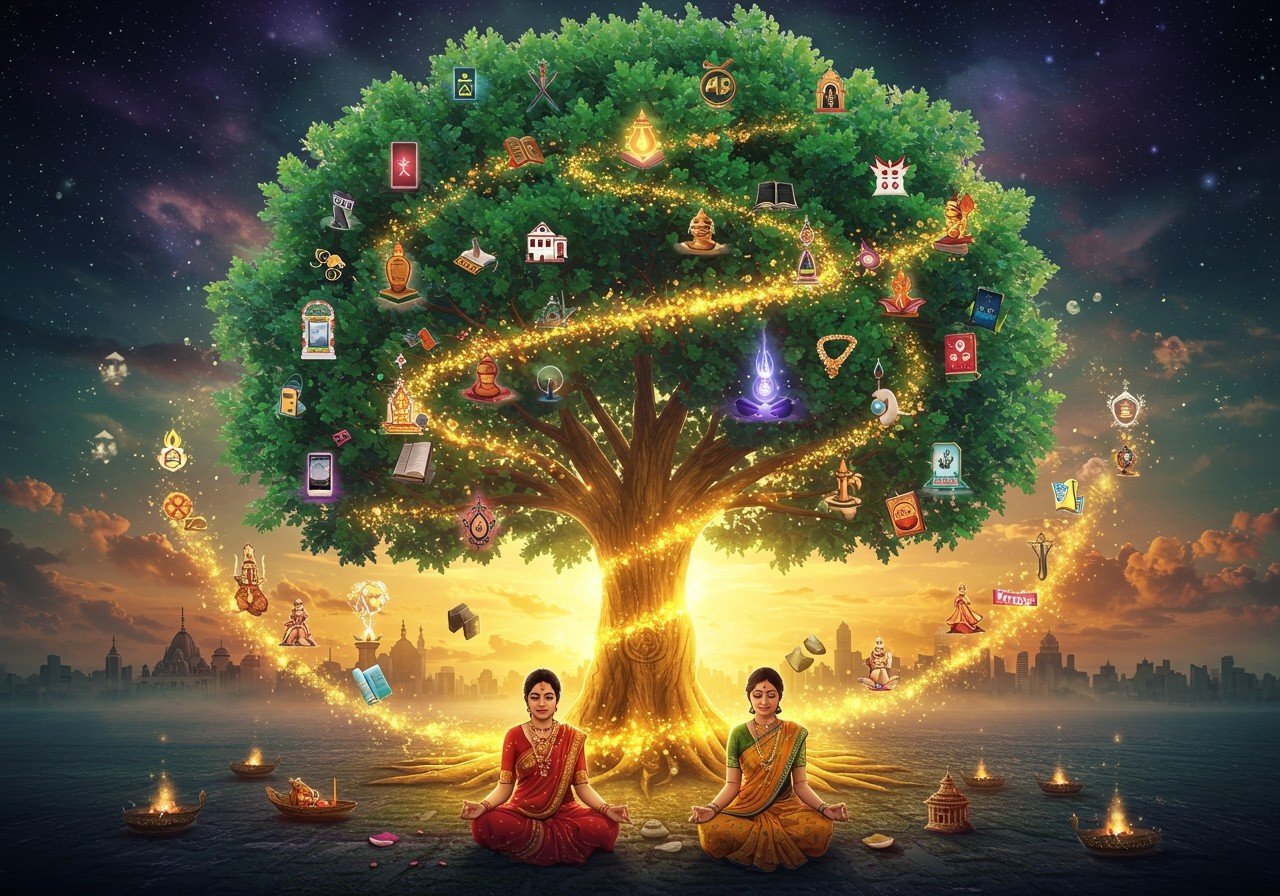
The Kalpavriksha, often called the “wish-fulfilling tree” or “tree of life,” holds deep meaning in Indian culture and mythology. Revered for its power to grant desires, it symbolizes prosperity, wisdom, and spiritual fulfillment. This blog explores the significance of the Kalpavriksha, its presence in our lives today, and how we can connect with its timeless legacy.
Mythological Roots and Cultural Importance
Ancient scriptures like the Rigveda and Puranas tell tales of the Kalpavriksha, born from the Samudra Manthan, the churning of the cosmic ocean. This divine tree, believed to reside in Indralok (heaven), became a source of boundless blessings for the Devas. Beyond mythology, the Kalpavriksha has permeated Indian art, architecture, and literature for centuries. Its image adorns temples and inspires countless stories, reflecting its profound influence on our cultural heritage.
For generations, families have passed down stories of the Kalpavriksha, creating a shared sense of wonder and reverence. Its symbolism has woven itself into the fabric of our traditions, reminding us of the importance of nature, spirituality, and the pursuit of a fulfilling life. You can further explore related topics in our articles on mindful rituals and the wisdom of the Vedas.
The Kalpavriksha in Contemporary India
Today, the Kalpavriksha stands as more than just a mythical symbol; it embodies ecological awareness and the importance of preserving our natural world. Its enduring presence inspires initiatives focused on biodiversity, sustainable living, and environmental protection. Communities across India are actively involved in planting and nurturing trees, recognizing their vital role in combating climate change and safeguarding our planet’s future.
From bustling cities to serene villages, local groups and NGOs organize educational workshops and tree-planting drives. These events bring people together, fostering a sense of community and shared responsibility towards the environment. Public parks and spiritual retreats now feature Kalpavriksha trees, creating spaces of tranquility where people can connect with nature and draw inspiration from ancient wisdom. Learn more about the significance of sacred plants in Hindu rituals.
Discovering the Kalpavriksha Near You
Across India, certain locations hold special significance, with trees revered as Kalpavrikshas. In Joshimath, Uttarakhand, a 1200-year-old Mulberry tree, believed to have sheltered Adi Shankaracharya during his meditation, stands as a testament to time and spirituality. Vrindavan, Uttar Pradesh, houses a sacred Banyan tree near the Madan Mohan temple, a place of reverence for devotees. In Hamirpur, Uttar Pradesh, a rare and ancient Kalpavriksha graces the banks of the Yamuna near Gayatri Tapobhoomi. Mangaliyawas, Rajasthan, boasts two majestic Kalpavrikshas, a male and female pair, over 800 years old. Visiting these sites offers a tangible connection to our cultural heritage and a chance to experience the reverence surrounding these living symbols.
Kalpavriksha Inspired Offerings and Gifts
The concept of ‘Upahara,’ or offering, holds deep significance in Indian traditions. The Kalpavriksha, with its association with abundance and blessings, has become a popular theme for gifts during festivals and special occasions. Presenting eco-friendly offerings aligns beautifully with the tree’s symbolism, promoting sustainability and respect for nature. Personalized gifts, such as planting a tree in someone’s name or offering handcrafted items inspired by the Kalpavriksha, carry deep meaning and create lasting memories. Choosing authentic and ethically sourced products ensures that these gifts truly reflect the cultural and spiritual significance of the Kalpavriksha. You can explore our curated collection of sacred threads, Harad seeds, and other traditional items at Poojn.in.
Poojn.in: Your Companion in Honoring Traditions
At Poojn.in, we offer a wide selection of authentic puja items to support your spiritual practices. We believe in providing high-quality, ethically sourced products that help you connect with your traditions meaningfully. Whether you’re seeking pure copper kalash, organic cotton wicks, natural incense, or traditional puja thalis, we have everything you need to create a sacred space in your home. Explore our range of Arjun Chal powder and Ashoka Chal powder, derived from sacred trees.
Embracing the Everlasting Legacy of the Kalpavriksha
The Kalpavriksha continues to inspire us with its message of abundance, wisdom, and the interconnectedness of life. By embracing its symbolism, we honor our rich cultural heritage and contribute to a more sustainable future. Whether through planting trees, participating in cultural events, or offering thoughtful gifts, we can all connect with the timeless legacy of the Kalpavriksha, fostering a deeper respect for nature and ensuring a harmonious future for generations to come.
FAQs: Understanding the Kalpavriksha
What does Kalpavriksha represent? The Kalpavriksha is a wish-fulfilling tree from Indian mythology, representing abundance, prosperity, and the fulfillment of desires. Its symbolism extends beyond material wealth to encompass spiritual growth and enlightenment. The tree’s ability to grant wishes highlights the power of intention and the potential for achieving one’s goals.
Are there real-life Kalpavriksha trees? While the Kalpavriksha is primarily a mythological concept, certain trees in India are revered as Kalpavrikshas due to their age, historical significance, or association with spiritual figures. These trees hold cultural importance and are often visited by people seeking blessings and connection with tradition.
What is the significance of Kalpavriksha Upahara? ‘Upahara’ refers to offerings or gifts, and in the context of the Kalpavriksha, it signifies expressing gratitude and seeking blessings. Traditionally, offerings like fruits, flowers, or symbolic items are made to the Kalpavriksha with prayers for prosperity and well-being. This practice reflects a deep connection with nature and the belief in the tree’s sacred power.
How does the Kalpavriksha remain relevant today? The Kalpavriksha transcends its mythological origins to inspire environmental consciousness and sustainable practices in modern India. Its image serves as a reminder of the importance of preserving our natural resources and promoting ecological balance. Furthermore, the Kalpavriksha continues to inspire artistic expression, cultural celebrations, and spiritual reflection, enriching our lives in countless ways.


